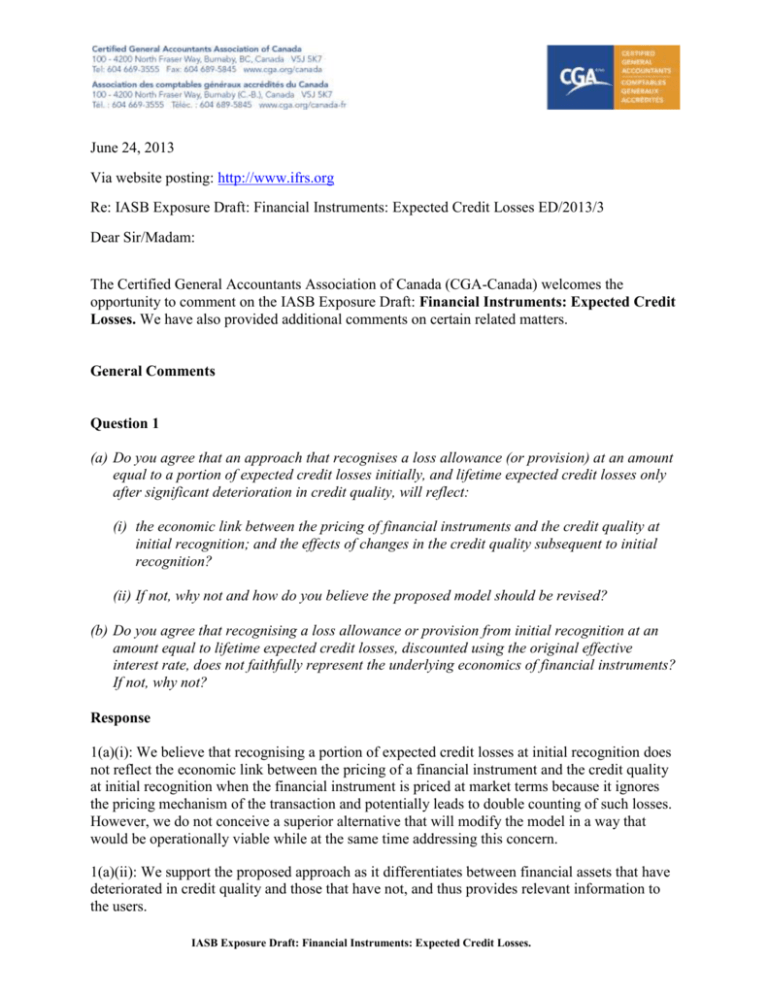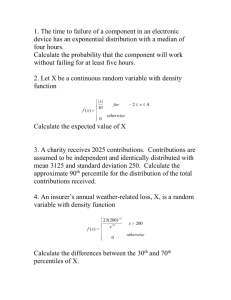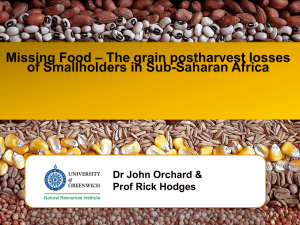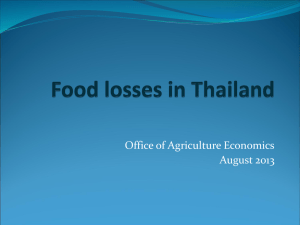20_1891_CarolAnn...ctedCreditLosses
advertisement

June 24, 2013 Via website posting: http://www.ifrs.org Re: IASB Exposure Draft: Financial Instruments: Expected Credit Losses ED/2013/3 Dear Sir/Madam: The Certified General Accountants Association of Canada (CGA-Canada) welcomes the opportunity to comment on the IASB Exposure Draft: Financial Instruments: Expected Credit Losses. We have also provided additional comments on certain related matters. General Comments Question 1 (a) Do you agree that an approach that recognises a loss allowance (or provision) at an amount equal to a portion of expected credit losses initially, and lifetime expected credit losses only after significant deterioration in credit quality, will reflect: (i) the economic link between the pricing of financial instruments and the credit quality at initial recognition; and the effects of changes in the credit quality subsequent to initial recognition? (ii) If not, why not and how do you believe the proposed model should be revised? (b) Do you agree that recognising a loss allowance or provision from initial recognition at an amount equal to lifetime expected credit losses, discounted using the original effective interest rate, does not faithfully represent the underlying economics of financial instruments? If not, why not? Response 1(a)(i): We believe that recognising a portion of expected credit losses at initial recognition does not reflect the economic link between the pricing of a financial instrument and the credit quality at initial recognition when the financial instrument is priced at market terms because it ignores the pricing mechanism of the transaction and potentially leads to double counting of such losses. However, we do not conceive a superior alternative that will modify the model in a way that would be operationally viable while at the same time addressing this concern. 1(a)(ii): We support the proposed approach as it differentiates between financial assets that have deteriorated in credit quality and those that have not, and thus provides relevant information to the users. IASB Exposure Draft: Financial Instruments: Expected Credit Losses. 1(b): We do not agree with an approach that requires lifetime expected credit losses to be recognised at initial recognition, as such an approach would result in excessive front-loading of credit losses and, as suggested in the response to 1(a) above, initial expectations of credit losses are already priced into a financial asset, and thus would provide less relevant information on credit deterioration. Question 2 (a) Do you agree that recognising a loss allowance (or provision) at an amount equal to 12month expected credit losses and at an amount equal to lifetime expected credit losses after significant deterioration in credit quality achieves an appropriate balance between the faithful representation of the underlying economics and the costs of implementation? If not, why not? What alternative would you prefer and why? (b) Do you agree that the approach for accounting for expected credit losses proposed in this Exposure Draft achieves a better balance between the faithful representation of the underlying economics and the cost of implementation than the approaches in the 2009 ED and the SD (without the foreseeable future floor)? (c) Do you think that recognising a loss allowance at an amount equal to the lifetime expected credit losses from initial recognition, discounted using the original effective interest rate, achieves a better balance between the faithful representation of the underlying economics and the cost of implementation than this Exposure Draft? Response 2(a): We believe that the proposed approach will result in a more timely recognition of expected credit losses and thus pragmatically addresses the deficiencies of the incurred loss model. 2(b): We believe that the approach in the ED achieves a better balance between the faithful representation of underlying economics and the cost of implementation of the approaches compared to the approaches in the 2009 ED and the SD (without the foreseeable future floor). 2(c): We believe that recognising the full lifetime expected credit losses from initial recognition does not result in an appropriate balance between the representation of the underlying economics and the cost of implementation. However, further field-tests may be necessary in order to better understand its ultimate impact on the proposals. Question 3 (a) Do you agree with the proposed scope of this Exposure Draft? If not, why not? (b) Do you agree that, for financial assets that are mandatorily measured at FVOCI in accordance with the Classification and Measurement ED, the accounting for expected credit losses should be as proposed in this Exposure Draft? Why or why not? Response 3(a): We agree with the proposed scope of this Exposure Draft and support the view that the IASB Exposure Draft: Financial Instruments: Expected Credit Losses. same impairment approach should apply for both loans and loan commitments, since they are often managed within the same business model and risk management systems. 3(b): We agree that the proposed impairment requirements should also apply to that FVOCI category. We also believe that it is important that both the amortised cost category and the FVOCI category are subject to the same impairment requirements, as this ensures comparability of amounts that are recognised in profit or loss for assets with similar economic characteristics. Also, we agree with the assessment of the IASB that mandating different impairment requirements would represent a source of complexity. Question 4 Is measuring the loss allowance (or a provision) at an amount equal to 12-month expected credit losses operational? If not, why not and how do you believe the portion recognised from initial recognition should be determined? Response It is contended that the answer to this question is contingent upon the Meta Analysis of the results derived from the field tests. Question 5 (a) Do you agree with the proposed requirement to recognise a loss allowance (or a provision) at an amount equal to lifetime expected credit losses on the basis of a significant increase in credit risk since initial recognition? If not, why not and what alternative would you prefer? (b) Do the proposals provide sufficient guidance on when to recognise lifetime expected credit losses? If not, what additional guidance would you suggest? (c) Do you agree that the assessment of when to recognise lifetime expected credit losses should consider only changes in the probability of a default occurring, rather than changes in expected credit losses (or credit loss given default (‘LGD’))? If not, why not and what would you prefer? (d) Do you agree with the proposed operational simplifications, and do they contribute to an appropriate balance between faithful representation and the cost of implementation? (e) Do you agree with the proposal that the model shall allow the re-establishment of a loss allowance (or a provision) at an amount equal to 12-month expected credit losses if the criteria for the recognition of lifetime expected credit losses are no longer met? If not, why not, and what would you prefer? Response 5(a):We agree with the proposal to recognise lifetime expected credit losses on the basis of a significant deterioration in the borrower’s ability to meet its contractual terms, because such credit deterioration would not have been reflected in the original pricing (i.e. interest rate) of the financial asset. Although we agree that it is appropriate to base the approach on a relative IASB Exposure Draft: Financial Instruments: Expected Credit Losses. deterioration of the credit quality, it would be necessary to resolve operational challenges. Also, there could be doubt on the correct interpretation and application of the terms such as “significant” and “deteriorating credit quality”. 5(b): We believe that the proposals provide sufficient application guidance on the assessment of a significant increase in credit risk that is also suitable to non-lending businesses. 5(c): We agree that the assessment for the recognition of lifetime expected credit losses should be based on changes in the probability of default, as it does not require the full estimation of expected credit losses and is aligned with existing credit risk management techniques. In addition, we note that linking the assessment to changes in the probability of default will provide users with additional information about credit quality and reveal whether the entity is mainly focussed on collecting interest revenue or focussed on recovering principal. However, we do have reservation that the current generally practiced risk management techniques can effectively factor in the extreme events such as the financial crisis of 2008. 5(d): We agree with the proposed operational simplifications, and believe that they achieve an appropriate balance between faithful representation and the cost of implementation. 5(e): We believe that both unfavourable and favourable changes in credit quality should be recognised in a consistent manner using the same principles and criteria, as this would provide comparability in the way entities account for similar items. Accordingly, we agree that an entity should be permitted to re-measure the loss allowance back to the 12-month expected credit loss when the criteria for the recognition of the lifetime expected credit losses are no longer met. Question 6 (a) Do you agree that there are circumstances when interest revenue calculated on a net carrying amount (amortised cost) rather than on a gross carrying amount can provide more useful information? If not, why not, and what would you prefer? (b) Do you agree with the proposal to change how interest revenue is calculated for assets that have objective evidence of impairment subsequent to initial recognition? Why or why not? If not, for what population of assets should the interest revenue calculation change? (c) Do you agree with the proposal that the interest revenue approach shall be symmetrical (ie that the calculation can revert back to a calculation on the gross carrying amount)? Why or why not? If not, what approach would you prefer? Response 6(a): We believe that the Exposure Draft considers the recognition of interest revenue and the recognition of expected credit losses separately. Hence, an entity recognises interest on the gross carrying amount without taking expected credit losses into consideration. However, we agree with the IASB’s conclusion in paragraph BC98 of the ED that “there are some financial assets that have deteriorated in credit quality to such an extent that presenting interest revenue on the basis of the gross carrying amount that reflects the contractual return would no longer faithfully represent the economic return”. IASB Exposure Draft: Financial Instruments: Expected Credit Losses. We also believe that such an approach will provide more useful information for users analysing the net interest margin. 6(b):We agree with the IASB’s conclusion that there are concerns about using ‘incurred loss’ criteria in an expected credit loss model, but it is necessary to retain the faithful representation of interest revenue, while minimising the operational challenges. The requirement to calculate interest revenue based on a net carrying amount when there is objective evidence of impairment increases the complexity of the impairment model. However, we agree with the IASB that, as preparers have been determining interest on the net amortised cost in a similar way under the extant IAS 39, no new complexity is added. Interest is viewed as compensation inclusive of expected credit losses. When credit losses become so significant that they can no longer be compensated by the interest revenue, different approaches can be used to measure the interest revenue. We believe that the IASB approach to calculate the interest revenue based on a net carrying amount when there is objective evidence of impairment is better than the non-accrual approach used by the FASB-model. The use of a non-accrual principle may permit an entity to postpone the remaining expected cash shortfalls in time without any effect on the allowance and does not, therefore, appropriately reflect the time value of the expected cash shortfalls. 6(c): We agree with the proposal that the interest revenue approach shall be symmetrical and provide comparability in the way entities account for similar items. Question 7 (a) Do you agree with the proposed disclosure requirements? Why or why not? If not, what changes do you recommend and why? (b) Do you foresee any specific operational challenges when implementing the proposed disclosure requirements? If so, please explain. (c) What other disclosures do you believe would provide useful information (whether in addition to, or instead of, the proposed disclosures) and why? Response 7(a): We generally support the proposed disclosures and believe that they will increase transparency and comparability, and provide relevant information about the credit quality of an entity’s financial assets and its risk management activities. We believe that the IASB should develop a robust disclosure framework which would specify not only what information needs to be disclosed, but also what flexibility might be appropriate in terms of how the information is disclosed. 7(b): We believe that, as stated earlier, specific operational challenges can be revealed only by the Meta Analysis of the results of field testing. 7(c): We suggest that the IASB should require disclosure about experience adjustments, which would allow users to understand the quality of earlier accounting estimates. IASB Exposure Draft: Financial Instruments: Expected Credit Losses. Question 8 Do you agree with the proposed treatment of financial assets on which contractual cash flows are modified, and do you believe that it provides useful information? If not, why not and what alternative would you prefer? Response We agree with the proposed treatment of financial assets whose contractual cash flows are modified, but also suggest that the standard needs to clarify when such modification results in derecognition. Question 9 (a) Do you agree with the proposals on the application of the general model to loan commitment and financial guarantee contracts? Why or why not? If not, what approach would you prefer? (b) Do you foresee any significant operational challenges that may arise from the proposal to present expected credit losses on financial guarantee contracts or loan commitments as a provision in the statement of financial position? If yes, please explain. Response 9(a): We support the proposals on the application of the general model to loan commitment and financial guarantee contracts because the application of the same impairment model is favoured for all the financial instruments subject to the simplification as appropriate. 9(b): As stated in our response to Question 4, we believe that the answer to this question is contingent upon the Meta Analysis of the results derived from the field tests. Question 10 (a) Do you agree with the proposed simplified approach for trade receivables and lease receivables? Why or why not? If not, what changes do you recommend and why? (b) Do you agree with the proposed amendments to the measurement on initial recognition of trade receivables with no significant financing component? If not, why not and what would you propose instead? Response 10(a): We agree with the proposed simplified approach for trade receivables and lease receivables. However, we believe that further application guidance is necessary regarding the application of the proposals to lease receivables. 10(b): We agree with the proposed amendment to IFRS 9 to measure trade receivables that do not have a significant financing component at the transaction price, as this would align the requirements of IFRS 9 with those proposed in the revenue recognition project. IASB Exposure Draft: Financial Instruments: Expected Credit Losses. Question 11 Do you agree with the proposals for financial assets that are credit-impaired on initial recognition? Why or why not? If not, what approach would you prefer? Response We agree with the proposals for financial assets that are credit-impaired on initial recognition because the proposed scope for assets to which the credit-adjusted effective interest rate would apply is consistent with the existing requirements in paragraph AG5 of IAS 39. Question 12 (a) What lead time would you require to implement the proposed requirements? Please explain the assumptions that you have used in making this assessment. As a consequence, what do you believe is an appropriate mandatory effective date for IFRS 9? Please explain. (b) Do you agree with the proposed transition requirements? Why or why not? If not, what changes do you recommend and why? (c) Do you agree with the proposed relief from restating comparative information on transition? If not, why? Response 12(a): We believe that it would be appropriate to allow entities a minimum of three years lead time to implement IFRS 9 after the completion of all phases of IFRS 9. Also, the IASB should ensure that IFRS 9 and the standard on insurance contracts become effective at the same time. 12(b): We suggest that the IASB should reconsider the transitional requirements of IFRS 9 to ensure that the restated comparative information is meaningful. Otherwise, we recommend that exemption from restating comparative information should be granted. 12(c): We believe that, subject to our comments in the answer 12(b) above, the IASB should consider that not requiring restatement of comparative information would force users to make certain adjustments for which they have less information relative to the preparers. Question 13 Do you agree with the IASB’s assessment of the effects of the proposals? Why or why not? Response We appreciate the IASB initiative to incorporate the effect analysis into the standard setting process. We believe that, paragraphs BC164-BC216 include useful information that will enable all stakeholders to understand and evaluate the potential effect of the requirements. IASB Exposure Draft: Financial Instruments: Expected Credit Losses. Additional Comments We are concerned that the IASB and the FASB are on divergent trajectories in respect of this particular issue. We continue to believe that convergence of standards for so fundamental an issue as accounting for impairment of financial instruments is critical for enhancing the comparability of financial statements across jurisdictions, and increasing the confidence of stakeholders in such reporting. We also believe that, in absence of converged standards for impairment, the entities employing IFRS as well as US GAAP will encounter significant implementation challenges. We also suggest additional implementation guidance so as to reconcile the proposed financial instruments impairment standards with the prudential capital framework, and avoid divergence in practice. Should you wish to discuss the contents of this comment paper or require further elaboration on any of the items presented herein, please do not hesitate to contact Kamalesh Gosalia at kgosalia@cga-canada.org or alternatively the undersigned at rlefebvre@cga-canada.org. Sincerely, [Original signed by:] Rock Lefebvre, MBA, CFE, FCIS, FCGA Vice-President, Research & Standards IASB Exposure Draft: Financial Instruments: Expected Credit Losses.








